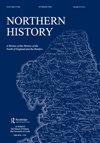约瑟夫·费斯特,《泰恩河畔纽卡斯尔的基尔门》1638–1852
IF 0.2
3区 历史学
Q2 HISTORY
引用次数: 0
摘要
弟弟迈克尔,娶了一位远房的布莱克特表亲。1705年威廉二世突然去世时,威尔金森接任了王位,只留下一个15岁的孩子来继承男爵头衔,但至少在最初没有继承企业。芬奇认为这是从个人管理向公司管理转变的早期例子,这种转变后来成为大公司的特点。也许是这样,但事实仍然是,威廉·布莱克特三世几乎没有能力为家族企业承担太多责任,尽管他的名字赋予了他芬奇所说的“品牌价值”,使他当选纽卡斯尔议员,尽管人们怀疑他同情雅各宾派。年轻的布莱克特的个性与他的祖先形成了鲜明的对比。他是一个挥霍无度、轻浮、自我放纵的花花公子,生了两个私生子,尽管最终嫁给了一位女继承人,但没有儿子,这意味着他能做的最好的事情就是在1728年早逝时将姓氏(字面上)留给年幼的侄子沃尔特·卡尔维利,条件是他必须娶女儿并取布莱克特的名字。当这位年轻女士被证明不情愿时,出现了一个暂时的小故障,但在威廉三世灾难性的任期内经营这些业务的经理们也管理着这部分业务,品牌名称得以保留。早些时候出现了一个“小故障”,布莱克特一如既往地引诱了他的经纪人约翰·威尔金森的女儿。威尔金森辞职了,但管理结构依然存在。正是在这一点上,提交人在他对布莱克特家族生存的描述中谈到了另一个因素:土地作为资本资产的相对经济地位不断提高,无论是在租金价值方面,还是在贷款和抵押贷款方面。Blacketts夫妇收购土地房地产是一个反复出现的主题,只有在矿产价格低迷和后来几年家庭财务面临压力时,这一主题才凸显出来。这是农业改良、圈地和提高租金价值的世纪。芬奇认为,良好的管理和对这笔土地资本的巧妙操纵使家族企业得以度过灾难性的第三代,以及煤炭贸易和铅市场的衰退。这本书经过了无可挑剔的研究,如果得出的一些结论有点推测性的话,它开辟了新的研究方向,毫无疑问,其他人将来会继续探索本文章由计算机程序翻译,如有差异,请以英文原文为准。
JOSEPH M. FEWSTER, The Keelmen of Newcastle upon Tyne 1638–1852
younger brother Michael and had married a distant Blackett cousin. It was Wilkinson who took over when William II died suddenly in 1705 leaving only a 15-year-old to inherit the baronetcy but not, initially at least, the businesses. Finch sees this as an early example of the sort of changeover from personal to corporate management that characterised large firms at a later date. That may be so, but the fact remains that William Blackett III was hardly equipped to take on much responsibility for the family businesses, even though his name gave him what Finch calls the ‘brand value’ to get him elected a Newcastle MP despite suspicions of Jacobite sympathies. The young Blackett’s personality was in marked contrast to that of his forebears. He was a profligate, frivolous, self-indulgent womaniser who fathered two illegitimate daughters and, although ultimately married to an heiress, no son, which meant that the best that he could do to save the family name was to leave it (literally) at his early death in 1728 to his young nephew Walter Calverley on condition that he marry his daughter and take the name of Blackett. There was a temporary glitch when the young lady proved reluctant but the managers who had carried on the businesses during William III’s disastrous tenure managed this bit of business too and the brand name was preserved. There had been an earlier ’glitch’ when Blackett, true to form, seduced the daughter of John Wilkinson, his manager. Wilkinson resigned but the managerial structure survived. It is at this point that the author homes in on another element in his account of the Blackett family’s survival: the growing relative economic status of land as a capital asset both in terms of rental value and as security for loans and mortgages. The acquisition of landed estates and property by the Blacketts is a recurrent theme which only comes to the fore during the depression in mineral prices and the pressure on the family finances of the later years. This is the century of agricultural improvement, enclosure and enhanced rental values. Finch contends that good management and clever manipulation of this landed capital enabled the family business to survive its disastrous third generation and a slump in both the coal trade and the lead market. The book is impeccably researched and if some of the conclusions reached are a touch speculative it has opened up new lines of enquiry which will no doubt be pursued by others in the future
求助全文
通过发布文献求助,成功后即可免费获取论文全文。
去求助
来源期刊

Northern History
Multiple-
CiteScore
0.20
自引率
33.30%
发文量
37
期刊介绍:
Northern History was the first regional historical journal. Produced since 1966 under the auspices of the School of History, University of Leeds, its purpose is to publish scholarly work on the history of the seven historic Northern counties of England: Cheshire, Cumberland, Durham, Lancashire, Northumberland, Westmorland and Yorkshire. Since it was launched it has always been a refereed journal, attracting articles on Northern subjects from historians in many parts of the world.
 求助内容:
求助内容: 应助结果提醒方式:
应助结果提醒方式:


